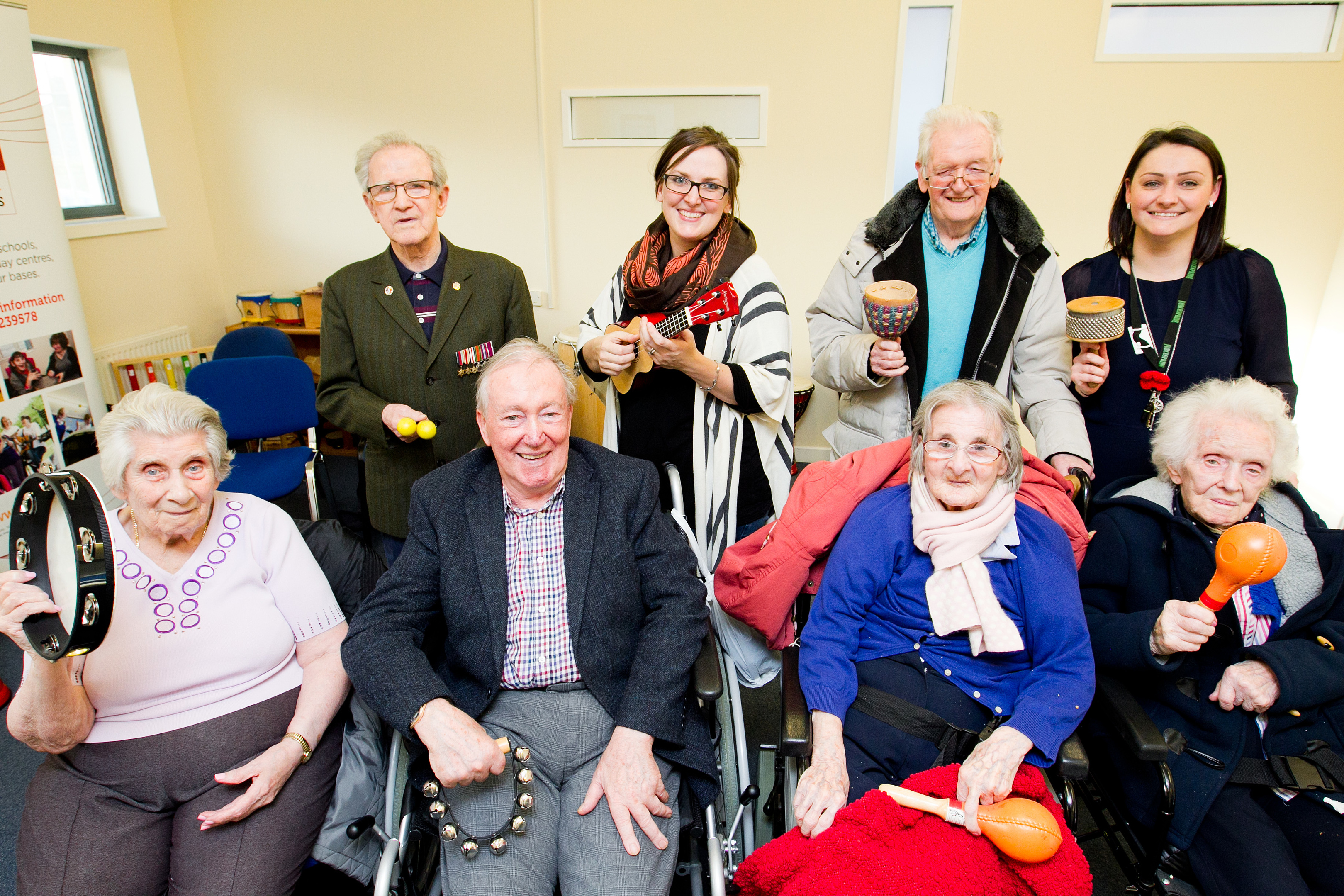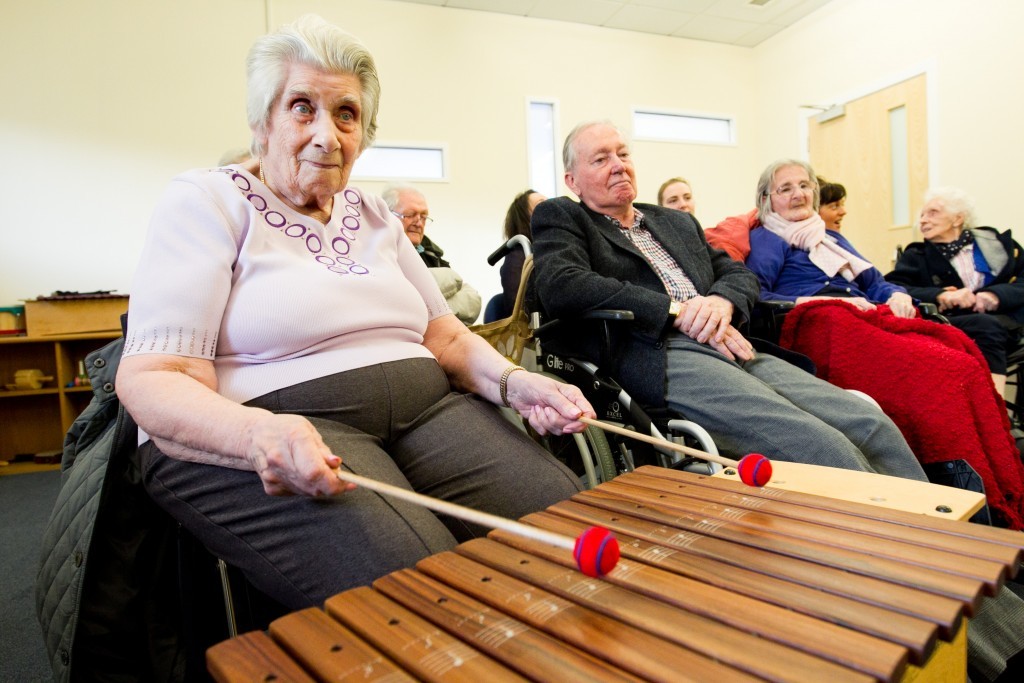
ALICE is asleep as the song begins, her lyric sheet hanging loosely in her thin hand.
The acoustic guitar strums the opening bars to Away In A Manger, and the voices lift up in unison.
Alice’s watery, red-rimmed eyes flicker, then open. Her lips immediately start moving and a soft whisper emerges.
“. . . no crib for a bed . . . the little Lord Jesus lays down his sweet head . . .”
Next to her, Margaret’s feet are bouncing gently on the footplates of her wheelchair and at the end of the row Isa has a childlike look of joy on her face as the carol hushes softly to an end.
They’re all residents from the Erskine Glasgow Home, and today, for an hour, they are at the Nordoff Robbins Scotland music therapy centre in Cardonald to sing with the Music Memories dementia choir.
Completing the ranks are the men in the group – Kenny, Kenneth and Vince – and their three carers, Karen, Jade and Donna.
The choir hasn’t been going long – just five months or so. The music therapy charity moved into its new centre back in June and it’s in one of its bright, warm rooms full of musical instruments, from bongos to bells, that the group gathers.
The six people here today (there are often more) have varying degrees of dementia.
Kenneth is talkative and smiley, and ex-forces man in a neat blue-grey jacket with a smart demeanour and a twinkle in his eye. He talks often about his wife and his life in the army, the clue to his condition in his repetition of stories and statements.
Margaret, meanwhile, is more deeply affected, unable to speak much and more childlike in her mannerisms. Vince, at the back, a row of medals pinned to his green blazer, is quieter, as is Alice.
Isa comes to life when the music plays, shoulders bouncing merrily and a cheeky smile on her face and happy gleam in her eyes. You should see her handle a xylophone, too – that woman has rhythm!
The person providing the tunes via guitar and piano is music therapist Joanne Edgar.
She is passionate about the power of music to connect with people living with conditions such as dementia.
“They say the auditory sense is the first to develop in the womb and it’s the last to go,” she says. “And we see evidence of that just about every day here – how deep it sits and the immediacy of it.
In late stage dementia it has a really powerful role to play. Where other things just are not connecting it can reach right in there.
“For instance Margaret is in the later stages of dementia. Her memory is just not there. But you watch her and she knows all the words to O Little Town Of Bethlehem, and that’s not easy – it’s somewhere deep in her brain.
“If you said to her ‘do you remember the lyrics to O Little Town Of Bethlehem’, she probably wouldn’t be able to string a few words together. But when the music starts it just unlocks something and the flow begins.”
Watching this process in action is fascinating, uplifting and moving all at once. It’s amazing to see the music opening doors in these people’s brains, leading them back through the years, yet still being absolutely in the moment and connected to those around them.
When the group had first come in, dropped off by mini-bus from the home, there was the usual hubbub and clamour of chat and laughs as everyone got settled and in place.
Then, beneath the noise, came a beautiful, soothing piano tune as Joanne tinkled the ivories. Gradually the attention was drawn to her. A gentle sign they were about to begin, without any clapping of hands or “right class, look at me!” declarations.
The first song of the day was Wild Mountain Thyme. A song they often play at the start as a sort of “we’re here, let’s begin” song.
The choir’s voices are a combination of the soft and the brittle. A little hesitant and unclear to begin with. Not very loud.
But they are transfixed by Joanne’s playing. A foot taps here, a head nods there. They’re just warming up.
“Bravo!” Kenneth bellows at the end of the song.

Then it’s into Loch Lomond and Mairi’s Wedding. The voices become stronger and louder – Kenneth’s in particular – and the smiles wider.
“The old traditional songs are always a favourite” explains Joanne later. “And we’ve done quite a lot of work with old children’s songs, like Ally Bally and the Jeely Piece Song. Things like that are just stored in another part of the brain.
“We’ve also done some ’60s music, like the Beatles and the Kinks, as well as some country and western like Johnny Cash.
“They really like Ring Of Fire and Ghost Riders In The Sky. There was one man who was here with his wife one week, and he was quite staid for the whole session, but when Ghost Riders started he started lassoing and whooping!”
A whole host of old favourites are covered – from Bonny Wee Jeanie McColl (“Aye, she’s doing fine!” calls Vince from the back when Joanne asks “What about Jeanie McColl?”) to Molly Malone.
“Molly Malone’s quite a sad song,” says Karen, who’s in charge of the carers. “Let’s have something happy.”
“What about some Christmas songs?” suggests Joanne.
So we take a trip through the festive classics. Everyone joins in with White Christmas and a lovely feeling of warmth envelops the room.
There are grins as wide as the Clyde when Jingle Bells rings out, and some actual jingle bells are found for Isa for Winter Wonderland. Her eyes light up at the sight and someone shouts “Go for it, Isa!”, which she does with gusto.
She’s on instrument duties again for a raucous blast through Wild Rover, when she’s handed the mallets for the big xylophone. She hits every beat of the song perfectly, and finishes with a cheeky wee “bong” at the end.
“Isa did ballroom dancing when she was younger so she has rhythm,” says Joanne. “They say she doesn’t recognise her own daughter, but you can see how much she’s getting out of this.
“She has the opportunity to use her musicality, and to feel well again – to feel like a valid, human part of what we’re doing.”
It’s this togetherness and connection that really makes what is happening in the room exceptional. That and the unlocking of something deep within that lets these people, drained and ravaged by a horrendous condition, shine once more.
The session ends in style with everyone chorusing I Love A Lassie. And then, all too soon, the minibus is here to take the choir back to the home.
“That was fun,” says Isa as she puts her big coat on.
“Yes, I enjoyed that,” smiles Kenneth.
Karen and Vince do the tango out of the door and the room is quiet once more.
Joanne looks happy as she sets her guitar down.
“It’s such a privilege,” she says. “That’s the word that sums up my entire job. To work with people and be able offer something to them that is valued and they get enjoyment from and you can share in that enjoyment. It’s really special.”
And having seen this incredible, inspiring choir in action, I’m singing from the same hymn sheet.
It is special indeed.

Enjoy the convenience of having The Sunday Post delivered as a digital ePaper straight to your smartphone, tablet or computer.
Subscribe for only £5.49 a month and enjoy all the benefits of the printed paper as a digital replica.
Subscribe